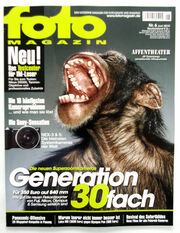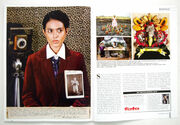


Wawi Navarozza wins the 2nd portfolio award by fotoMAGAZIN
"100 YEARS BETWEEN US"
(NAVARROZA HOMAGE TO KAHLO BIRTH CENTENNIAL)
Wawi Navarroza interviewed by Manfred Zollner, FotoMAGAZIN, Germany
Manfred Zollner: What attracted you to the Kahlo project?
Wawi Navarroza: One hundred years after the birth of Frida Kahlo, I was appointed to work on an exhibit for the commemoration of her birth centennial (1907-2007) by Instituto Cervantes de Manila. The curator Jose Fons Guardiola saw my solo exhibit in that same year and thought my works and I reminded me of her. Now I have to be honest... I was unfamiliar with Frida Kahlo's work. I only know about her persona. Her image. And precisely because of that, I thought it was interesting. How superficial my initial knowledge was--as we all are--when it comes to how we look at icons and figures in popular culture. Theoretically, I was interested on the notions of identity that Frida Kahlo clearly put forward... in which, with this work of mine, I connected specially to how it related to Photography and the recorded image. On the other hand, at heart, I was curious and eager to learn more about her in a personal way, without the noise of media and other commercial fabrications. The first intention was an homage and then a commentary using Photography to speak about about our reception of images. I wanted to know the iconography of her Likeness, our fascination with the Open Wound.
MZ: What artistic challenge has this project brought to you?
WN: There is a danger to do a 'homage' and fall into the trap of piggy-backing on a famous artist, nonetheless a worldwide Mexican zeitgeist such as Frida Kahlo. How do I tell her story and at the same time, claim this work as a critical piece of my own? I just did what my questions led me and how Photography can play a part in defining it. For me, there is always consciousness with the medium.
The first challenge was research. Her iconography has been romanticized, commercialized in many different ways so i had to peel away much of these layers that covered the facts behind her. Another challenge was gathering the materials for the sets and costume. It was a domestic production. I did it alone with the help of my family who prepared the flowers and fruits, my then-boyfriend who pulled the camera trigger, a painter friend, some neighbors who made the dresses, lent me coconuts and a goat. Everything was shot in-camera, the elements were not digitally composited. There were times that I needed to manually tilt the objects (ex. the table) to compensate for perspective. Otherwise, all the techniques were basic photography and lighting.
MZ: How did you approach it?
WN: I did a lot of experimental black and white work then, almost exclusively for my gallery shows but for this project I realized I can only do it in full color. Except for one or two pieces that are originally my created tableaus (The Painter's Garden, Inmortal), I've chosen to re-stage the paintings of Frida and photograph it as Self-Portraits. Those are the 2 things that the Mexican artist signifies for me: her paintings, her self-portraits. There is no other way to represent this than by turning the mirror face to face with itself, to copy the paintings into photographs. And see the fascinating things it presents.
There's also an attempt to re-introduce the stories behind the works that she made. For example, my piece Still Missing (You) is a play on words. It's based on the more obscured works of Frida Kahlo "La Mesa Herida" (The Wounded Table), one of her largest paintings which is until now still lost to the public since its exhibition in Moscow with Diego Rivera in the 1950s.
One Hundred Years Between Us is a set of photographs that are directly appropriated and/or re-imaged from Frida Kahlo's existing paintings. Some images have added text and little poems assuming the ex-voto/retablo style popular in Mexico and Kahlo's works. I picked out the ones that resonated with me the most and translated it through acting it out and sometimes, celebrating the parallelisms in our lives that cross over.
It's not an unusual fact that there is a shared pathos between Mexico and the Philippines both a colony of Spain at some point, both sitting on the same equatorial tropical latitude, both countries sanguine, warm and colored, with a certain love for music and sentimentality, and a peculiar darkness borne, i think, by being steeped in poverty and succored by religion. However, these are observations and not the main point of my work but there is no denying the history. So in a way, it's a hall of echoes. Parallelisms. Synchronicities. Maybe this could be a bit of a stretch, her father is a photographer and so was my grandfather, and maybe we have the same dress size. One can still smell her perfume in her recently discovered dress. It has paint stains and holes from cigarettes.
In sum, the photographs in the series One Hundred Years Between Us is a homage from me to Frida but has the quality of a deadpan sort of nostalgia. It is a borrowed life, a tourism on appearance, a mimicking, an homage, an image that is recycled and repeated like a song many times over, a hymn for a broken time that has lost its trust in poetry and the sentimental. At the same time, a celebration of the unapologetic feminine, the flowers, the fruits, the dresses, the lush earth, and ultimately, the exalted heart that can stitch itself back again and again. Bang. Bang.
This series has been shown at the Instituto Cervantes de Manila in 2007, Verso Galeria Arte Contemporanea (Torino, Italy) in 2009 and at the Hangaram Museum, Seoul Arts Center (Seoul, Korea) in 2010. Wawi Navarroza is represented by Silverlens Gallery, Manila.
wonderland, photographers:network, selection 2010
June 26 – July 4, 2010
studio Thomas Kellner, Siegen, Germany >>>









